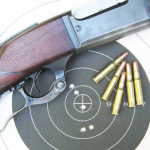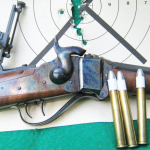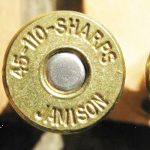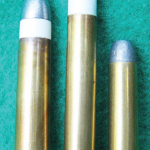- The .303 Savage performed well with the Jamison brass.
- Jamison is the only current maker of .45-110 Sharps brass.
- The Jamison head-stamp is a welcome sight again.
- A .45-70, on the right, looks small next to the .50-90 and .45-110.
by Mike Nesbitt
Contributing Editor
Some of the best news reloaders can get is the announcement that Jamison Brass is back in business. Why their business was interrupted for a few months is something I don’t know and, quite frankly, I don’t care. The real thing to know is that they are back, making very good brass cases again for a very wide range of handgun and rifle cartridges, including African game cartridges, hunting, military, self-defense and many obsolete, as well as loaded ammunition.
What are the most interesting to me are the obsolete cartridges that Jamison is now making available again both for the brass cases and for loaded ammunition, too. Let me quickly admit, I don’t have any experience with their loaded ammo but my voice will cry out in admiration for their brass. So let me tell you about a couple of the cartridges I’ve used their brass with and I can throw out a couple more cartridge numbers as well.
My fondness for the .303 Savage has probably been noticed before. The old Savage 99s in .303-caliber just seem to beg for more attention and, with the new Jamison brass, that attention is easy to give. Rather recently I got a batch of 20 new .303 cases from Jamison and those were taken to the loading bench right away. After being primed with CCI Large Rifle primers, the cases were charged with 29.0 grains of IMR #3031 powder and then “corked” with some .308-inch diameter Hornady 180-grain round nose bullets.
Those bullets were seated with the cannular well down into the .303’s neck so the loaded rounds had an overall length not exceeding 2½ inches.
That load almost duplicates the old Remington/Peters loading with their 180-grain bullet and my handloads crossed the chronograph with an average velocity of about 2,050 feet per second (fps). While that is a bit slower than what the Hornady bullet is actually designed for, it is still good and well within the working range for the .303. What’s more, my old 99R in .303 Savage showed it can put those loads to good use by putting the bullets into a 2½ inch group on a 100-yard target.
Those new brass cases put the .303 Savage back in business. Jamison also is making new brass for the .22 Savage Hi-Power and for the .250 Savage as well. For other shooters with obsolete calibers, look to Jamison for new brass to load the old .25, .30 and .32 Remington rimless cartridges. We can keep naming some other old smokeless powder rounds too, such as the .33 Winchester for the good old Winchester Model 1886 and for the .35 Winchester to load in the box magazine Model of 1895. They are even making new brass for the Winchester .351 and .401 SLRs, Winchester’s “self loading rifles.” The old Newton rifles get a new lease on life with Jamison brass too; they are making new cartridge cases for the .256 Newton, the .30 Newton and the .35 Newton.
One big area where the new Jamison brass will be highly appreciated is with the old blackpowder cartridges, both for the Cowboy Action shooters and for the blackpowder cartridge rifle shooters.
Those are two separate groups of shooters although their borders often cross, especially in the area of the cartridges they both might use.
For instance, Jamison makes all of the brass cartridge cases used in the old 1876 lever-action Winchester, including the .40-60, .45-60, .45-75, and the big .50-95. I don’t know of another source for those cartridges.
Another area where Jamison seems to be the exclusive maker is for some of the Sharps cartridges such as the .40 caliber straight cases; including the .40-70 Sharp Straight and others with that same rim size. Yes, that also includes the .405 Winchester plus the old .38-72 and the .40-72. More Sharps numbers are found in the .44-77 and the .44-90, two bottleneck cartridge cases that are hard to duplicate or form from other brass. The list actually goes on and if you have a special buffalo gun you want to reload for, just look at Jamison’s complete list, they probably make what you need.
While I can’t go on naming everything Jamison makes brass or ammo for, let me continue by telling you about two more calibers that they produce new brass for, which I have tried.
Those two calibers are the .45/2-7/8- inch Sharps and the .50/2½ inch Sharps. The .45/-2-7/8 is the longest cartridge actually made by Sharps back in the late 1870s and it is more commonly known today (especially after the movie “Quigley Down Under”) as the .45-110. Also the .50/2½-inch is also better known as the .50-90 Sharps although Sharps never loaded it with less than 100 grains of powder. The .50- 90 loading was from UMC in the 1880s.
These are two very worthy cartridges and Jamison is the only maker at this time for the .45-110 cases.
When I loaded some of the new cases for those two Sharps cartridges I found the brass to be a little “tight.” Those cases didn’t need to be sized but they sure needed to be expanded to accept the cast bullets. My real intention is to use this new brass with paper-patched bullets but my first loadings in those Sharps calibers was done with greasegroove bullets so the brass could be fire-formed. After shooting with the grease-groove bullets, the brass will be expanded nicely and paper-patch bullets can be loaded with ease.
So, the first loading in the .45-110 cases was done with 90 grains of GOEX Fg powder under a 535-grain “Postell” bullet. While that isn’t the top loading, it is plenty! My 13 pound Model 1874 rifle from C. Sharps Arms really roared to life and provided fuel for amazing echoes from a distant hillside. This shooting was being done mainly to fireform the brass but one round was fired over a chronograph just for curiosity and the speed recorded was 1,270 fps.
At the same time a batch of the .50- 90s was fire-formed, loaded with 90 grains of GOEX Fg again but with a 450-grain cast bullet on top of the powder. That was the standard bullet for the .50-70 Gov’t. My favorite bullet for the .50-90 is a 500-grain paper patched slug and that’s what would be loaded as soon as the brass was prepared by being fired. And the .50-90 was also checked for speed, with a rewarding 1,280 fps.
That very evening the .45-110 and the .50-90 cases were de-primed, cleaned, and reloaded with the preferred paper patch bullets. Now they’re ready for some good blackpowder cartridge rifle shooting whether it be in the matches or on a good hunt.
Jamison International is now a division of Captech International.
Their new “digs” fill 31,000 square feet in Rapid City, SD. “Many unique cases are currently available in stock and more are in production each week,” said a company spokesperson.
For more information, contact: Captech International, Jamison International Division, 2441 Dakota Craft Dr., Dept. TGM,, Rapid City, SD 57701; phone: (605) 791-1974. To see if they make the brass you want, just check the Jamison website at: captechintl.com/products. You’ll find the website a great source of information







